#Zahra Wafa
Text
When Zahra Wafa thinks about what it took to put her daughters through school, her face hardens.
She remembers the days she and her husband ate only bread to afford their children’s education, how it had all seemed worth it to give them a chance at a future beyond Nawa Foladi, a village in central Afghanistan with a single dirt track, hand-pumped wells and no electricity.
Then Wafa remembers the new reality under the Taliban, and her voice falters at the thought that it might all have been for nothing.
“We worked hard, spent so much money on this and they’re so intelligent. And now they’re supposed to just sit at home?” she said. “Every time I think about it I get a headache.”
A year after the precipitous fall of the U.S.-backed republic and the Islamic militants’ ascension to power, Wafa and her daughters, like so many women and girls across Afghanistan, are grappling with the Taliban’s hard-line vision for the country and its plan to turn back the clock not only on their education but their very presence in public life.
The group claims it has no interest in restoring its 1990s regime, when girls were banned from school and almost all jobs, and endured corporal punishment for violations such as not wearing a burqa in public. Yet every few months, new decrees are issued about which careers women may have, how far they may travel without a male guardian and what they may wear outside the home. One edict said the most devout women would not leave the house at all, unless there’s need.
Earlier this month, the Afghan Ministry for the Propagation of Virtue and Prevention of Vice — which occupies the building that once housed the Women’s Affairs Ministry — ordered women to be banned from entering amusement parks. A few days later, it banned them from gyms and hammams, public baths that were already segregated by sex.
Secondary schooling has been an especially sore point. In the fall of last year, authorities allowed Afghan girls to enroll in primary schools and universities and promised to resume secondary education at the start of the new school year March 23. But that day, as high school girls streamed into classrooms, officials reversed course and postponed classes indefinitely until “a comprehensive plan has been prepared according to sharia and Afghan culture.”
Last month, they allowed female students who were in 12th grade before the republic’s collapse to take the university placement exam known as the Kankor — but blocked off majors they deemed inappropriate for young women to pursue, including economics, engineering, journalism and veterinary medicine.
....
Wafa now contemplates the loss of all that. Her eldest, 20-year-old Meena Ibrahimi, had finished 12th grade before the Taliban takeover; she planned to study law and aspired to become a member of parliament or a diplomat representing Afghanistan at the United Nations.
“Of course none of that will happen now,” Ibrahimi said.
She had waited for more than a year to take the Kankor, but didn’t bother applying for law or anything else not related to medicine, one of the few fields open to women under the Taliban.
“The Taliban don’t care about the constitution or women’s rights. If the situation continues, those who study law won’t be employed,” she said.
At least she wasn’t in limbo like her sister Zainab. A 16-year-old 10th grader, Zainab hoped to be a doctor, an achievable dream if it were possible to finish her secondary schooling. But with those schools shuttered, Ibrahimi’s class will be the last cohort of Afghan girls and young women to enter university.
“The first time the Taliban took over, it was my mother who had to bear the consequences. Now, 20 years later, we’re suffering the same thing,” Ibrahimi said, glancing at Wafa, who looked at the floor, a tight frown on her face and tears slowly filling her eyes.
12 notes
·
View notes
Text
Israeli military uses drones to kill Palestinians in West Bank’s Tulkarem
Israeli forces killed at least five Palestinians in the occupied West Bank’s Tulkarem on Sunday morning, taking the toll in Israeli raids, including drone strikes, in the occupied territories to seven in the last 24 hours.
Two of the victims were killed in drone strikes while several others were injured in the large-scale military offensive in Tulkarem, the Palestinian Wafa news agency reported, quoting the local media and medical sources.
Wafa identified the victims as Jihad Aarneh, 25, Mahmoud Samer Jaber, 22, Ghayth Yasser Shahada, 25, Waleed Asaad Zahra, 22, and Asaad Asad Zahra, 33.
At least two Palestinians were killed on Saturday in two separate incidents in the occupied West Bank.
The incidents on Saturday killed 20-year-old Aziz Abdulrahim Ekhlail and 25-year old Salem Nasser Hajar.
Israel’s army confirmed its forces used aircraft to target Palestinians in the town, saying it struck and killed fighters who had launched explosives at them from the Nur Shams camp.
Following the air raid, Israeli forces prevented ambulances from reaching the camp and arrested one paramedic, Wafa reported. The Israeli forces also carried out a large-scale raid with tanks and bulldozers, according to Wafa.
Also on Sunday, a Palestinian died from injuries sustained after an Israeli attack in Jenin several days earlier, the Palestinian Ministry of Health said.
Al Jazeera’s Charles Stratford, reporting from the Tulkarem refugee camp, said the raid began at 1am on Sunday and lasted nine hours. He said Israeli forces fired projectiles from drones at people in the camp and, according to residents, blocked ambulances from entering to treat the wounded for four hours.
“About 17,000 people are living in this camp and they are facing raids like this pretty much every day,” Stratford said.
“The situation highlights not only the kind of territory that thousands of civilians are facing, but the huge difficulties that medical crews face as these raids continue,” he said.
Israeli military raids and settler attacks have intensified in the occupied West Bank since the Gaza war broke out on October 7.
During this time, at least 297 Palestinians have been killed by Israeli forces and settlers, making it the deadliest year on record in 18 years.
The death toll includes at least 65 children, with a further 3,365 injured.
Israeli authorities have also stepped up the arrests of Palestinians in the occupied West Bank and East Jerusalem since October 7, with more than 4,500 people detained in the past two months, according to the Palestinian Prisoner’s Society.
In the besieged Gaza Strip, at least 18,787 Palestinians, mostly women and children, have been killed in Israeli attacks since October 7, according to the territory’s Health Ministry.
Israel says the Hamas attack on Israel that day killed 1,139 people, most of them civilians.
95 notes
·
View notes
Text
Three Palestinians shot dead by Israeli occupation forces in Jenin
JENIN, Friday, October 27, 2023 (WAFA) - Three Palestinian young men were shot dead and 12 others were wounded by Israeli gunfire last night as a large contingent of Israeli occupation forces stormed the city of Jenin and the surrounding outskirts, according to local and medical sources.
Dr. Wisam Bakr, the director of Jenin Public Hospital, confirmed the killing of two young men. Abdullah Basam Abu Al-Haija, a resident of the town of Yamun, west of Jenin, who succumbed to multiple gunshot wounds across his body.
Another young man, Ayser Mohammad Al-Amer from the Jenin refugee camp, was also confirmed killed in the Israeli raid.
After the Israeli occupation forces withdrew from Jenin and its refugee camp, local residents discovered a third Palestinian killed among the trees near the Martyr Shireen Abu Akleh Street, adjacent to the Jenin refugee camp. The slain Palestinian was identified as Jawad Al-Turki.
During the Israeli raid, Israeli occupation forces fired at an ambulance and and prevented it from reaching the injured Al-Amer. The forces left him to bleed until he tragically succumbed to his wounds, medical sources said.
Earlier in the night, a large Israeli military force, accompanied by two D9 bulldozers, launched an incursion into Jenin. The forces carried out searches and raids in the vicinity of the Ibn Sina Hospital, the Zahra neighborhood in the city, and the outskirts of the Jenin camp. Snipers were deployed in these buildings and houses.
Additionally, Israeli bulldozers engaged in extensive excavation activities on the outskirts of the Jenin camp, damaging streets, infrastructure, and the main water supply pipeline to the camp.
Israeli occupation forces further sealed off the roads leading to the camp using earthen barriers, attempting to isolate it, especially from the adjacent city of Jenin.
With the tragic losses of Abu Al-Haija, Al-Amer, and Al-Turki, the number of Palestinians killed by Israeli occupation forces in the West Bank since October 7 has risen to 109, with over 1,900 individuals sustaining injuries.
(27 October 2023)
#preemptively: don't bother whinging at me about the news source. fuck you and fuck your cnn#palestine#zionism#west bank
40 notes
·
View notes
Text
Israeli warplanes bombed Al-Wafa medical center for elderly care in Zahra area. 60 elderly and medical staff were sheltering inside. Killed and injured on spot.
And, It is with deep sadness that we report the loss of Dr. Midhat Mhessen, the Director of Wafa Medical Center, among the Palestinians murdered by Israeli warplanes’ bombing on the medical center.

#gaza#fucking hell#free gaza#gaza strip#gazaunderattack#free palestine#save gaza#palestine#freepalastine🇵🇸#idf
5 notes
·
View notes
Text
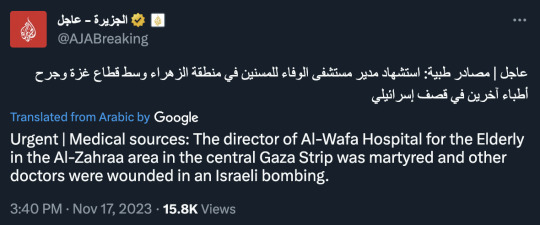
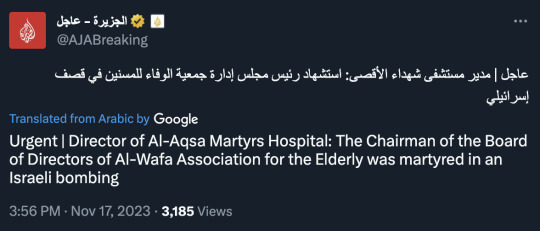
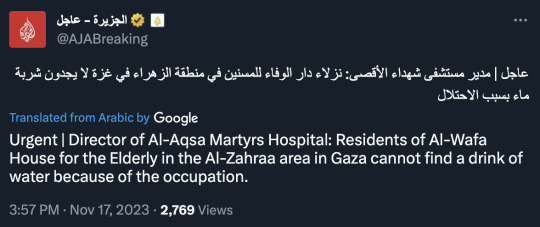
israeli airstrikes have hit the Wafa Elderly Nursing Home in Zahra, south of Gaza City, according to Roya News and Al Jazeera.
4 notes
·
View notes
Text
Wafa, salito a 4 bilancio palestinesi uccisi a Tulkarem
E’ salito a quattro il bilancio dei palestinesi uccisi in un’operazione israeliana nel campo profughi di Nour Shams nei pressi di Tulkarem in Cisgiordania.
Lo ha rifgerito l’agenzia Wafa che cita fonti mediche. I due uccisi – secondo la stessa fonte – sono Walid Abdel Razzaq Asaad Zahra (22 anni) e Asaad Fathi Asaad Zahra (33). In precedenza altri due palestinesi – secondo la stessa fonte – erano…
View On WordPress
0 notes
Text
swastamita 2023 part 3
part 3 of swastamita 2023 review
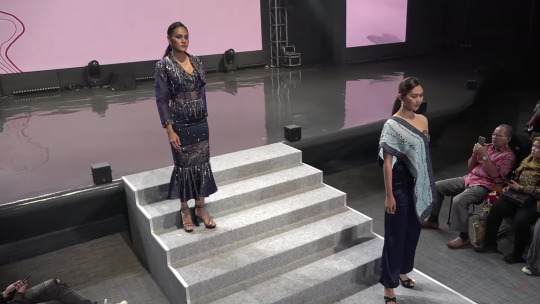
gusti ayu fina puspawati & mega oktaviyanti titled poise. the looks are elegant. both of it done really well but there's no cohesiveness on the 2 design. it feels like its from 2 different theme. it still a great clothes 8/10.
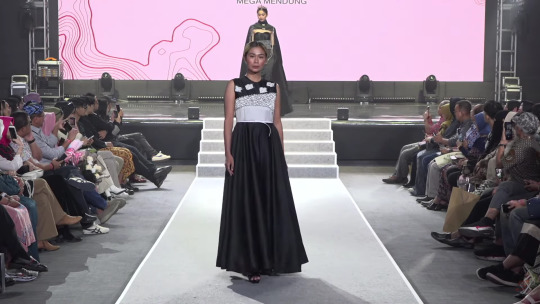
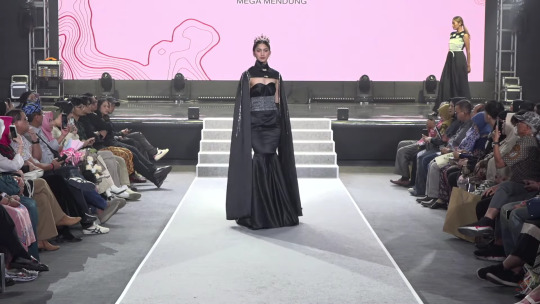
nazhira zahran & anggita tri ayuningtyas titled mega mendung. okay i like the second one and for the first one i found it kinda ugly. the first one looks like slapped together with no care for balance on the design. if for only look 2 i'll give it 8.5/10 but since i be judging it based on the collection i'll give it 6.5/10.
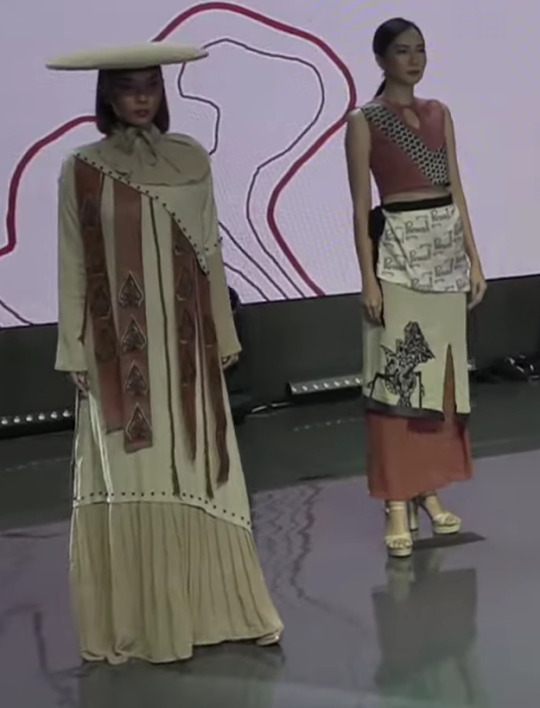
viela sofa hanifah & vina nurhendriyani titled mahyang. this looks is soooo good the design is really muach muach chef kiss. it's clean. the vision is there. 8/10

salma haniah & hanna yulianty pratiwi titled suka cita, i like the colour n silhouette but that flower pattern kinda look bad. old people shit i dont like it. it honestly ruin the whole clothes 6.5/10

adisha namira & wafa nabila putri titled javan leopard. i dont really like the colour of the left one. it looks messy but its not that bad. the second one i really like its simple n classy. ill give it 7/10.
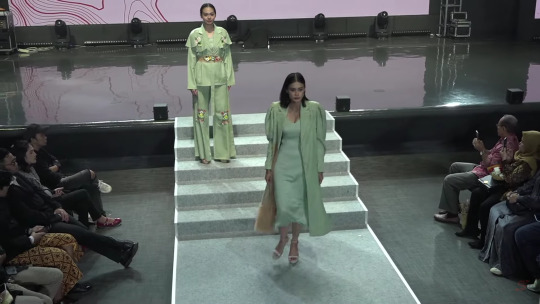
jihan fadilla & amalia rachma attorik titled festive d'tomohon. this one like an old school shit like 1960's shit that only focus with the beauty of it. it looks really good but u know its not rei review without hating on old school shit. 7/10.
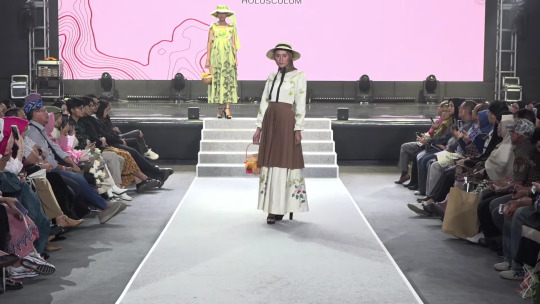
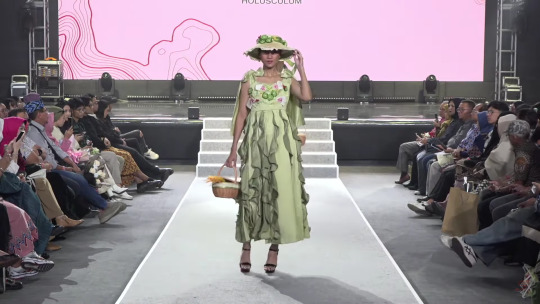
eliene austriani & ghina pramesti titled holusculum. i never really into the cotage core look but this is fit the style n it looks really good especially the second one. its really easy to look at. its soft n flowy. 7/10
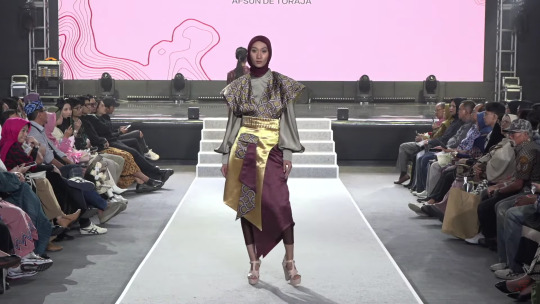

devi selviana tiurina & syarifah niswayul khaira titled afsun de toraja. when everything is the main character no one ended up getting the spotlight. that's how i feel about this looks everything is so loud it ended up become just incoherent noise. 6.5/10.
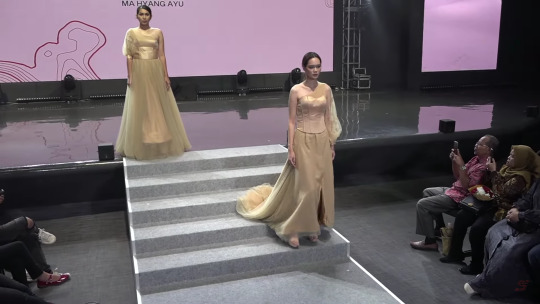
devi maya oktaviani & mindy nanda nabilah titled mahyang ayu. the asymmetry is fun, it elevate the design but the silhouette still just a simple one. ill give it 6.5/10.
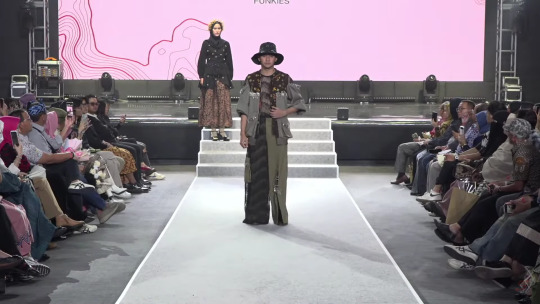
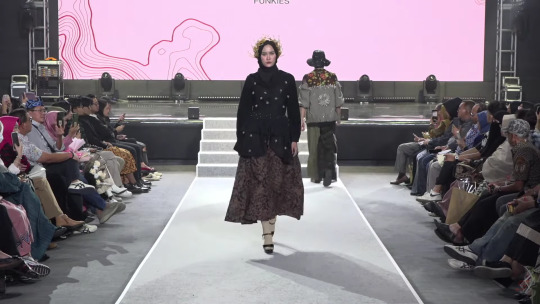
ardea regina ginting & salma halimatus sadiyah titled funkies. now this is what i love. this has a big vibe that punk vibe that jun takahashi vibe that i really love. this collection grab my heart and attention. 9/10


andini pramestisya putri & kiffa cecilia titled dharma dewata. this one is classy the choice of colour make it more intimidating i love it. it kinda remind me of alexander mcqueen. 8/10

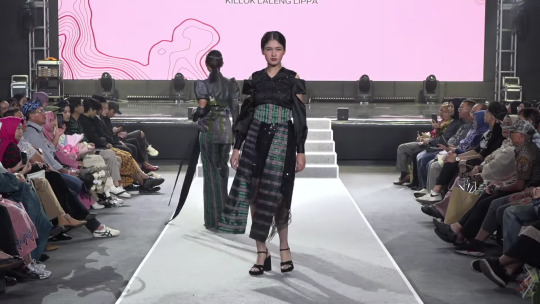
mutiara azahra & raisa zahra titled killok laleng lippa. this one have the same problem with the selviana tiutina & syarifah niswayul khaira collection. incoherent white noise. 6.5/10.
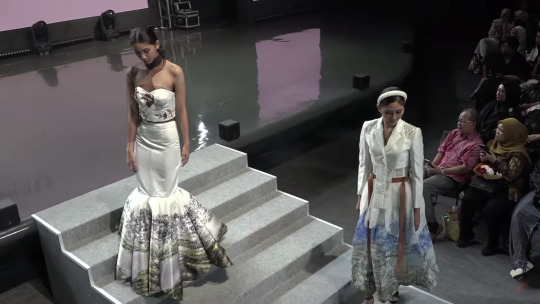
ayu fitriani & nanda aryandita titled cartenz pyramid. this one is beautiful. the asymmetry with the sleeve on the left look is really muach muach chef kiss i really like it 7.5/10.


alya najwa rachman & rifa dzahabiyyah titled lereng samudra. this is cool the colour is as themed. but the thing i really love is that depth effect that created by making the colour blue transition from light to dark. 8.5/10.
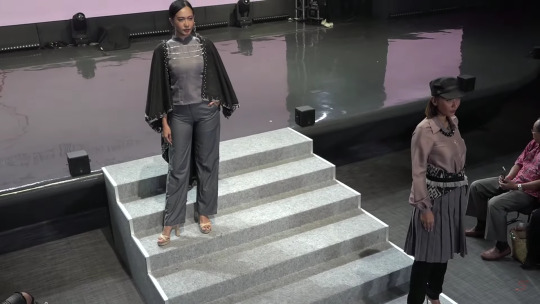
nadira zahra syihab & syifa sabilla adriana titled surga kecil diujung timur indonesia. this is simple n clean. looks modern. it's giving girl boss. 7/10.
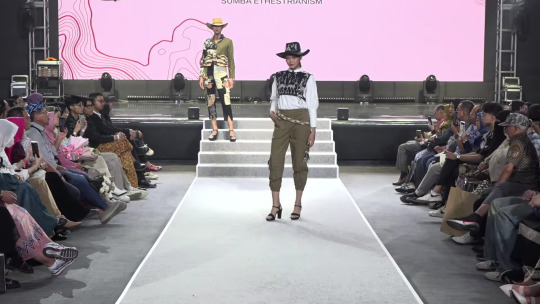
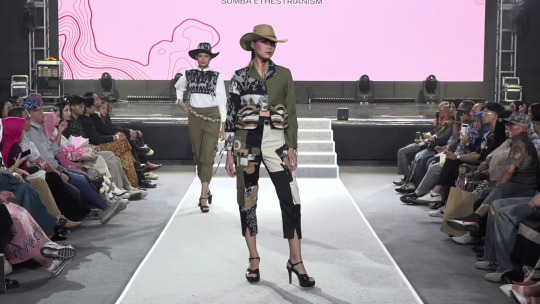
tiara ovelia & queenie salsabila bismutia titled sumba ethestrianism. i dont hate the cow girl look. yeehaaww 6.5/10
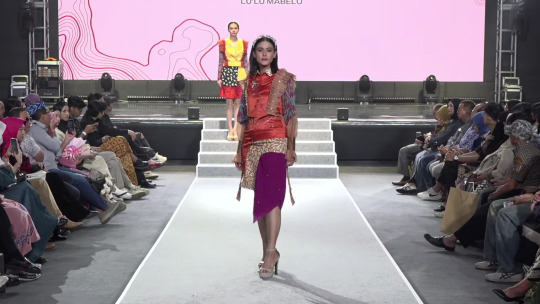
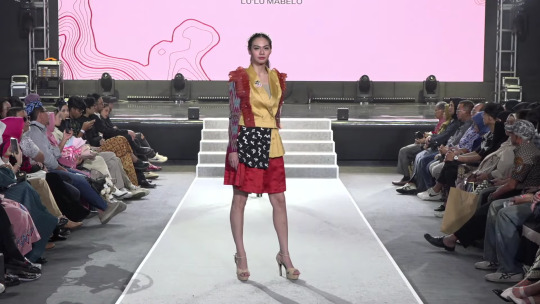
auranisa dyah qonita & jilan harizhah jauza suhendar titled lu'lu mabelo. this is loud in a correct way. it screams "look at me" and when u look at them u werent disappointed. 7.5/10.
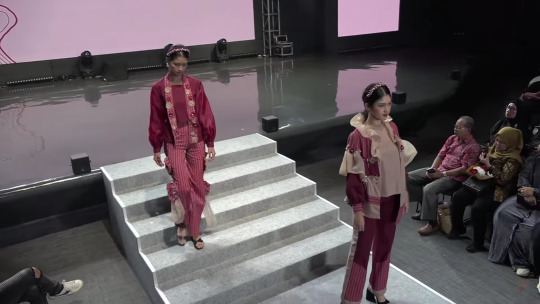
olivia & anggun futikatun ni'mah titled lirik loorik. it looks kinda boring even tho its loud. its the annoying kid that want attention. 6.5/10

agnes herlynn eka putri, fika aulia putri hamim & putri syifa salsabila titled putri nayanika. this one i like it. the design is playful with that asymmetry that done excellently. ill give it 7/10.
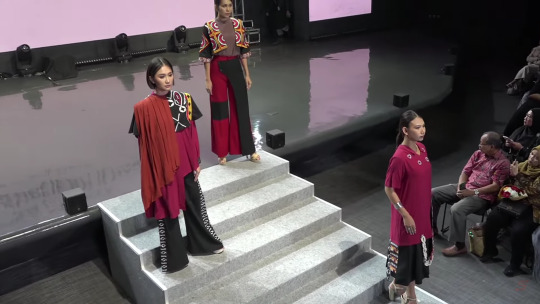
dinar nurdani, zahra ardhya & farah khofifah ilham titled the story of toraja. i see the vision but it isn't done amazingly, it's just okay. its really look bland. 6/10.
0 notes
Text
Palestiniens : Tsahal a commencé à avertir les habitants de Gaza des prochaines attaques contre des bâtiments résidentiels
Jeudi soir, l’armée israélienne a détruit quatre immeubles d’habitation dans le quartier d’al-Zahra, au centre de la bande de Gaza. Selon l’agence de presse officielle palestinienne Wafa, l’armée israélienne a averti à l’avance les résidents de 270 appartements des attaques à venir, et les résidents ont réussi à évacuer.
Ce rapport indique des changements dans la tactique de Tsahal dans la…

View On WordPress
0 notes
Text
नोहा लिरिक्स इन हिंदी Noha Lyrics in Hindi New
Hum Azadar Hain Lyrics
नोहा लिरिक्स इन हिंदी Noha Lyrics in Hindi New
Hussain Ya Hussain Ya Hussain Ya Hussain
Labaik Ya Hussain Labaik Ya Hussain
Ya Hussain Ya Hussain Ya Hussain
Ya Hussain Labaik Ya Hussain Labaik Ya Hussain
Hum Azadar Hain Hum Azadar Hain,
Shah E Mazloom Ke
Hum Azadar Hain, Hum Azadar Hain,
Kin Hamaray Liye Aap Zahra Dua,
Hum Hain Sab Se Alag
Hum Hain Sab Se Juda Haathoun Me
Apnay Hay Alam E Shah E Wafa,
इसी तरह की और भी लिरिक्स पड़ने व सुनने के किए यह क्लिक करे LyricsWisdom.com
#नोहा_लिरिक्स_हिंदी#नोहा_लिरिक्स_न्यू#हिंदी_नोहा_गीत#नए_नोहे_के_लिरिक्स#नोहा_गीत_हिंदी_में#Noha_Lyrics_Hindi#New_Noha_Lyrics_Hindi#Hindi_Noha_Songs#Latest_Noha_Lyrics#Noha_Lyrics_In_Hindi
1 note
·
View note
Text
Jahan Hussain Wahan La Ilaha Illallah Lyrics
Charagh Jalta Raha
Jo Qafila Tha Rawan Woh Qafila Hai Rawan
Safar Ba Nok E Sinan Sinan Ky Sath Azan
Bureeda Sar Ki Sadayen Fiza Mein Phail Gaiin
Dareechon, Aanganon, Galiyon Mein Dabty Sehra Se
Zameeno Arsh, Khilaun Se Aur Fizaon Se
Dinon Mein, Rat Mein, Jangal Mein, Kohsaron Se
Sadayen Any Lagiin Ash Hadu An La Ilaha Illallah
Yeh Aik Bar Hua Aur Lazawal Hua
Sinan Ki Nok Pe Subhana Rabbi Al Aala
Pukara Kalma E Toheed Bhi Jazak Allah
Jahan Hussain Wahan La Ilaha Illallah
Khateeb E Nok E Sinaan La Ilaha Illallah
Hussain Deen Bhi Hai Aur Deeniyat Bhi Hai
Hussain Kalma E Toheed Ki Hayat Bhi Hai
Hussain Ramz E Khuda Bhi, Khuda Sifaat Bhi Hai
Hussain Baara Imamon Ki Kayenaat Bhi Hai
Hussain Se Hai Ayaan La Ilaha Illallah
Jahan Hussain Wahan La Ilaha Illallah
Khateeb E Nok E Sinaan La Ilaha Illallah
Woh Goud Fatima Zehra Ki Ho Ky Raig E Tapaan
Woh Sehn E Kaaba Ho Pusht E Rasool Ya Ky Sinaan
Fazaye Jang Ho Ya Ho Payam E Aman O Amaan
Na Dekhy Teer Na Talwar Gar Ho Hukm E Azan
Hussain Ka Hai Bayan La Ilaha Illallah
Jahan Hussain Wahan La Ilaha Illallah
Khateeb E Nok E Sinaan La Ilaha Illallah
Hussain Walon Ki Pehchan Hai Azadari
Hussain Walon Ki To Jan Hai Azadari
Hussain Walon Ka Emaan Hai Azadari
Hussain Walon Ka Ailaan Hai Azadari
Hussainiyat Ki Zuban La Ilaha Illallah
Jahan Hussain Wahan La Ilaha Illallah
Khateeb E Nok E Sinaan La Ilaha Illallah
Basi Hai Karbobala To Koi Jawaz Bhi Hai
Luta Hai Gulshan E Zahra To Koi Raaz Bhi Hai
Yeh Raaz Woh Hai Ky Khaliq Ko Is Py Naaz Bhi Hai
Baraye Naaz Bahattar Ki Woh Namaz Bhi Hai
Isi Ki Sirr E Nihaan La Ilaha Illallah
Jahan Hussain Wahan La Ilaha Illallah
Khateeb E Nok E Sinaan La Ilaha Illallah
Namaz Nafs Ki Izzat Hai Aoliya Ki Qasam
Namaz Deen Ki Hurmat Hai Aosiya Ki Qasam
Namaz Husn E Sharafat Hai Anbiya Ki Qasam
Namaz Qissa E Wehdat Hai Kibriya Ki Qasam
Namaz Khair E Amal Ki Taraf Bulati Hai
Namaz Ish E Khuda Ka Hunar Sikhati Hai
Namaz Abd Ko Mabood Se Milati Hai
Namaz Guftagoo Allah Se Karati Hai
Yehi Namaz Gunahon Se Bhi Bachati Hai
Namaz Qabr Talak Sath Sath Jati Hai
Namaz Woh Hai Jo Faqon Mein Mustafa Ne Parhi
Jaga Ke Apny Hi Qatil Ko Murtaza Ne Parhi
Jo Chakion Ki Mushakat Mein Fatima Ne Parhi
Galy Laga Ke Zahar Ko Jo Mujtaba Ne Parhi
Jo Chahta Ke Azmat Namaz Ki Dekhe
Mery Hussain Ka Woh Akhri Dekhe
Parhi Namaz Jo Abid Ne Pusht E Naqa Par
Ada Kiya Jisy Baqir Ne Sakhtian Seh Kar
Bayan Kiya Jisy Jafar Ne Barsar E Mimbar
Rukoo Mein Barson Rahy Jis Ke Kazim E Muztar
Raza Ny Lab Pe Sareeh Ar Riza Saja Ke Parhi
Taqi Ny Taqwa E Bu Talibi Bata Ke Parhi
Naqi Ne Nakhwat E Batil Mita Mita Ke Parhi
Aur Askhari Ne Khabar Akhri Suna Ke Parhi
Pas E Namaz Musallay Pe Ro Raha Koi
Imam E Asr Hai Aur Hujjat E Khuda Hai Wohi
Jahan Hussain Wahan La Ilaha Illallah
Khateeb E Nok E Sinaan La Ilaha Illallah
Woh Khaima Gah Wo Syedanian Woh Zikr E Khuda
Jahan Musallay Pe Zainab Rubab Aur Fizza
Hasan Ki Baiwah Ruqaiyah, Sakina Ka Sajda
Tamam Bibian Karti Thiin Sirf Aik Dua
Mere Khuda Hamen Manzoor Qeht E Aab Rahe
Hussain Apny Iradon Mein Kamyab Rahe
Sadaye Tishna Laban La Ilaha Illa Allah
Jahan Hussain Wahan La Ilaha Illallah
Khateeb E Nok E Sinaan La Ilaha Illallah
Magar Namaz Se Poocho Ky Karbala Kya Hai
Hussain Aur Tera Rishta E Wafa Kya Hai
Kaha Namaz Ne Sun Lo Meri Baqa Kya Hai
Bas Aik Sajda E Shabbir Ke Siwa Kya Hai
Hussain Hi Ka Gharana Bacha Gaya Mujh Ko
Woh Khud Ujarh Gya Lekin Saja Gya Mujh Ko
Mayan E Karbobala Aah Mainy Kya Dekha
Ghira Laeenon Mein Kunba Rasool Ka Dekha
Batool Zadon Ko Bay Aab O Bay Ghiza Dekha
Bahata Pani Udhar Lashkar E Jafa Dekha
Namaz Parhte Rahe Dill Mein Iztarab Na Tha
Guzar Gaye Thy Kai Din Ke Ghar Mein Aab Na Tha
Bataun Kaisy Ke Dasween Ko Mainy Kya Dekha
Sahar Hui To Shahadat Ka Silsila Dekha
Kisi Ka Seena To Zakhmi Koi Gala Dekha
Lab E Furat Alam Khoon Mein Bhara Dekha
Hussain Lashon Pe Lashe Yun Hi Uthate Rahe
Aur Apni Rah E Shahadat Ki Simt Jaty Rahe
Kamar Rukooh Ki Tarah Thi Magar Hussain Uthe
Ky Ahl E Zulm Py Lazim Tha Ab Ky Taigh Chale
Ghazab Ki Taigh Chali Koi Rokta Kaisy
Imam E Waqt Thy Allah Ki Riza Pe Ruke
Azan E Asr Suni, Dekha Aalam E Bala
Kaha Hussain Ne Subhana Rabbi Al Aala
Aai Sada E Ghaib Ibadat Ka Waqt Hai
Ay Fatima Ke Laal Tilawat Ka Waqt Hai
Jannat Mein Saf Bandhi Hai Imamat Ka Waqt Hai
Bas Bas Hussain Bas Yeh Ibadat Ka Waqt Hai
Rakh Li Mayan Mein Shah E Bala Ne Zulfiqar
Woh Ghol Bandhy Aye Kamaan Dar Das Hazaar
Woh Bay Shumar Taighon Ke Phal Aur Ek Hussain
Woh Sainkarhon Payam E Ajal Aur Ek Hussain
Dooby Huye Thy Khoon Mein Gaisoo Hussain Ke
Teeron Ne Chaan Dale Thy Pehloo Hussain Ke
Naizay Ka Bin E Wehb Ne Pehloo Pe Kiya Waar
Kandhy Thy Chali Sath Zarara Ki Bhi Talwar
Nawak Bine Kahil Ka Kalaijy Ke Hua Paar
Bazo Mein Dar Aya Tabar E Khooli E Khon Khuwar
Taighen Opi Huiin Jo Barabar Se Chal Gaiin
Ghash Kha Gaya Qadam Se Rakaben Nikal Gaiin
Kiun Kar Kahun Ky Arsh E Khuda Khak Pe Gira
Khair Un Nisa Ka Mah E Laqa Khak Par Gira
Raiti Py Mustafa Ke Jigar Ka Lahu Gira
Syed Gira Imam Gira Naik Khoon Gira
Woh Zulm Ho Raha Tha Ky Duniya Ulat’ti Thi
Jab Zair E Taigh Gardan E Shabbir Kat’ti Thi
Woh Tund Taigh Zainab O Zahra Py Chalti Thi
Matam Kunaan Namaz Thi Aur Khoon Roti Thi
Jari Thi Yeh Sada Ky Nabi Ka Nawasa Hon
Amman Pilao Pani Main Pyasa Hun
Ajab Ada Se Namazi Namaz Parh Ke Gya
Bahan Ke Samny Nok E Sinaan Pe Charh Ky Gya
Nazar Mein Bhai Ke Sajde Ki Aab O Taab Jo Thi
Behan Ny Sar Khule Maqtal Mein Maghribain Parhi
Nazar Ky Samne Har Meh Laqa Ki Laash Rahi
Magar Jale Huye Khaimon Ki Ja Namaz Bichi
Gham E Hussain Ki Barchi Utha Gai Zainab
Magar Namaz Ki Duniya Basa Gai Zainab
0 notes
Text
A year in, the Taliban escalates its war against girls' education in Afghanistan
#Taliban #Afghanistan #education
When Zahra Wafa thinks about what it took to put her daughters through school, her face hardens.
She remembers the days she and her husband ate only bread to afford their children’s education, how it had all seemed worth it to give them a chance at a future beyond Nawa Foladi, a village in central Afghanistan with a single dirt track, hand-pumped wells and no electricity.
Then Wafa remembers the…

View On WordPress
0 notes
Link
Ya Allah,Ya Muhammad,Ya Ali,Ya Fatima,Ya Hassan,Ya Hussain,Ya Jafir Sadiq,Ya Zainul Abideen,Ya Ali Naqi,Ya Ali Taqi,Ya Mola Askari,Ya Mehdi,Ya Baqir,Ya Abbas,Ya Akbar,Ya Asghar,Ya Qasim,Ya Qaim e Alay Muhammad,AS,Ya Raza,Ya Mussa,Ya Sajjad,Ya Abid e bemar,Ya hassan askari,Ya Qamar e banihashm,Ya Imame Zamana,Ya Nabi,Ya Rasool,Ya Murtaza,Ya Mustafa,Ya abu talib,Alay imran,ali ali haider,ali ali mola,mola mushkil kusha,mola ali madad,ya ali madad,Ya Allah Madad,mushkil hal kro,hasnain ka baba,Ya Hasnain,Hasnain sharifain,Hassan mujtaba,sabaz e qaba,alamdar,shaheed e karbala,Waris e doo jahan,wafa ka paker,shehnsha e wafa,bina e la illah,karbala ka mojza,karbala ki zameen,noha,qasida,manqabat,marsiya,sooz o salam,kaba e man karbala,qibla e man ya hussain,makkah e mozma,madina e munawra,qaidi,zam zam,aby e shifa,pani,tapti dooph,nehar e furat,pyasa,karbala ki dastan,karbala,karbala ki jang,dastan e karbala,iran,iraq,mashhad,qum,bibi e qum,baghdad ka qaidi,kofa,bazar e sham,masoom e qum,maqtal,mehndi,jhola,ziarat,zuljanah,Alam,Talwar,Teer,Neza,Mashaq,Khanjar,Khema,Namaz,Naat,Quran,Arfana Kalam,Sufiyana Kalam,13 Rajab,10 Muharram,4 Shoban,3 shoban,15 Shoban,3 Jamad ul Sani,21 ramzan, shahdat,19 ramzan,25 rajab,25 muharram,28 safar,18 jeth,9 muharram,Nawasa e Rasool,Panjtan Pak,Jigar Gosha e Batool,Ya Zahra,Ya Zainab,Ya Bibi,Ya Syeda,Ya Masooma,Ya Makhdooma,Ya Mahrooma,Ya Binte Rasool,Ya Binte Ali,Zikar e alay Rassol,Milad,Jashan,Majlis,Islamic Conference,Zulfan Madni diyan,Zulafqar,Haider e qarar,Mola,Noor e Aain,Zikar e Rasool,Labyak Ya Rasool,Labaik Ya Hussain,12 Rabiul Awal,17 Rabiul Awal,Salam Ya Hussain,Ya Rehman,Muzamil,Salman,Abuzar,Qambar,Malik e Ashtar,Ya Sughra,Ya Sakina,Aoun o muhammad,jhon,Rahib,Khurasan,sham,lailah illah,Ali un Wali Allah,janta ul baqi,imam bargah,
1 note
·
View note
Photo
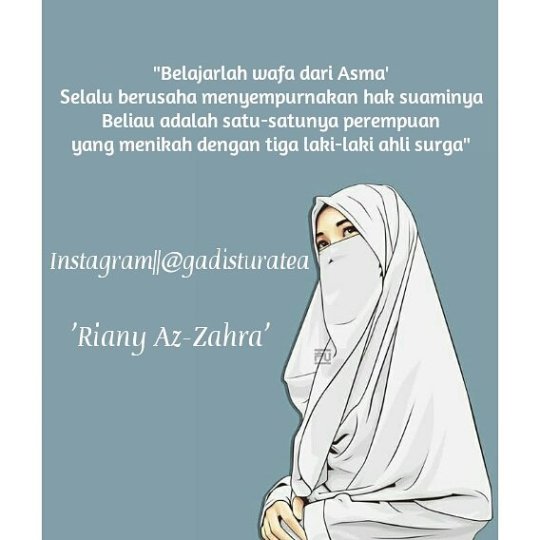
. Perempuan satu-satunya yang menikah dengan tiga laki-laki ahli surga. (Ja'far bin Abi Thalib, Abu Bakar Ash-Shidiq, dan Ali bin Abi Thalib) Ialah "Asma' binti Umais" . -- Beliau adalah sosok teladan yang begitu aku kagumi. Akhwat mukminah yang sudah sepantasnya menjadi motivasi bagi kita yang ingin segera menikah. Belajarlah wafa terlebih dahulu dari Asma' . . . Penghormatan yang diberikan terhadap suaminya membuat aku terkagum-kagum. Bahkan Rasul pun menyuruh Fatimah untuk belajar darinya perihal ketaatan kepada suami. Betapa perempuan semulia Asma' harus rela menjadi seorang pelayan bagi laki-laki yang amat dicintainya. Ialah Ja'far suami tercinta. Karena sebaik-baik pelayan adalah istri kepada suaminya. Beliau memanjakan mata suaminya dengan selalu tampil cantik di depannya. Berdandan seakan ingin bertemu seseorang yang paling istimewa. Iya. karena bagi seorang perempuan, tidak ada yang lebih istimewa daripada suaminya setelah ayahnya. Beliau kerap memanjakan lidah suaminya dengan masakan terbaik yang disuguhkan setiap harinya. Ia tidak ingin mengecewakan suaminya sedikitpun. Beliau selalu memberikan pelayanan terbaik hingga tidak pernah tidur mendahului suaminya. Ketika Ja'far bangun dari tidurnya, Asma berkata; . "wahai suamiku, pasti hari ini aku masih banyak kekurangan dalam melayani kamu, belum menyempurnakan hak-hak kamu, dan aku tidak ingin Allah marah kepadaku nanti di akhirat, maka biarlah aku tebus di dunia saja. Ambil sapu ini dan pukullah aku jika kamu belum puas, jika kamu belum ridha dengan apa yang aku lakukan" Ja'far tidak memukulnya. Malah memluk Asma' dan makin cinta kepada beliau. Belajarlah dari Asma'.. . . Kisah ini membuat mataku sembab. Inilah sejatinya cinta. Sebagai istri yang baik, kepatuhan terhadap suami adalah hal utama. Karena surgamu terletak pada keridhaan suamimu. . . ----- Silakan ingatkan saya jika ada yang keliru dari kata-kata di atas. Terimakasih. . . 📝@gadisturatea 'Riany Az-Zahra' -----
60 notes
·
View notes
Text
Sri Lanka urged not to violate fundamental rights in the name of combating terror
We the undersigned, who are from and live in the various nation-states of South Asia, express our deepest condolences to all those who have lost loved ones in the serial bomb blasts in Sri Lanka on Easter Sunday. We express our solidarity with those working tirelessly to address the needs of the injured in the aftermath of this carnage and to sustain interfaith and community relationships.
While we support all justice efforts that seek to hold the perpetrators of violence accountable, we also urge the Government of Sri Lanka to ensure that, in the name of combating terror and ensuring national security, fundamental human rights and dignity of all concerned are not violated.
We say this because in all our countries, investigations into terror and anti-terror legislation have been accompanied by consistent and continuing violation of civil and democratic rights. Furthermore, in the name of ensuring national security, successive governments in the region have sought to legitimise their various acts of impunity – directed against not only purported or possible suspects but entire sections of the civilian population. This has led to unaccountable loss of life and a steady erosion of democratic guarantees and institutions, including unaccounted for deaths and disappearances.
We note with concern that media reports and remarks by state officials and political leaders in Sri Lanka have pointed to State inaction with respect to warnings by intelligence agencies about possible acts of terror. Such inaction and indifference, we regret to note, amounts to State complicity with the violence that subsequently unfolded.We are also concerned that the ‘owning up’ to these acts by the so-called ‘Islamic State’ (Daesh) might encourage Islamophobic attitudes and expressions, both on the part of the Sri Lankan Government and sections of civil society. Should this happen, Sri Lanka would be tragically drawn in to a familiar international discourse and practice to do with ‘Islamic terror’ with all the resultant tragedies, as we have witnessed across Asia. In a country that has barely recovered from decades of civil mistrust, war and violence, this cannot bode well for its sovereignty, civil peace and economic and social life.
We wish to point out that the so-called war on ‘Islamic terror’ has resulted in large numbers of the Islamic faith being persecuted, both in their countries and across the world – and this sadly only enhances the appeal of those who seek to wage war in the name of Islam and what they perceive as Islamic concerns and interests. Thus is set in motion a cycle of violence that benefits no one but the arms trade and industries, and political powers that seek to establish their hegemony in the region at all costs.
In this context:
nWe support all struggles to ensure transparent and fair pursuit of justice for the victims of the blast. At the same time, we stand with those who are against undemocratic anti-terror laws in Sri Lanka, even if they are purportedly deployed for purposes of investigation and national security.
nWe protest attempts to target or persecute those of the Islamic faith, in the name of countering terror, whether by the state or vigilante groups.
nWe support Muslim communities in the region that have called for peace and are critical of voices from within that endorse extremist religious positions, which polarise everyday life and interactions, and vitiate meaningful dissent and dialogue.
nWe affirm the resilience of diverse cultural and religious traditions in the region that have fostered longstanding habits of mutuality, trust and co-existence. We do not wish for the specificity of local beliefs and traditions, of all faiths, to be drawn into polarising global discourses of religious ‘unity’ and ‘singularity’ imposed from above.
List of signatories:
Afghanistan
Massihullah, Kabul Afghanistan
Sima Samar, Afghanistan
Nepal
Anju Kandel, Nepal
Deepa Gurung, Nepal
Hari Sharma, Kathmandu, Nepal
Kaalo.101, Nepal
Kanak Mani Dixit, Kathmandu
Kunda Dixit, Kathmandu, Nepal
NayanTara Gurung Kakshapati, Kathmandu, Nepal
Niranjan Kunwar, Kathmandu, Nepal
Sarita K.C, Nepal
India
Mangai, India
Abha Bhaiya, India
Abirami Jotheeswaran, India
Amar Kanwar, New Delhi, India
Anuradha Bhasin, Kashmir Times, India
Anuradha Kapoor, India
Arundathi V, India
Ashish kumar Dey, India
Bindu Doddahatti, India
Deepti Sharma, New Delhi, India
Dia Da Costa, India
Dipta Bhog, India
Farida Khan, India
Forum Against Oppression of Women, India
Geetha V, India
Huma Ahmed-Ghosh, India
Indu Vashist, India/Canada
Iram Saeed, India
Jinee Lokaneeta, India/USA
K, Lalita, India
Kamla Bhasin, India
Khalida Saleem, India
Madhu Mehra, India
Mamta Singh, Women Right Activist, India
Mary John, India
Maya Sharma Vikalp (Women’s Group), India
Meena Gopal, India
Meera Velayudhan, India
Mohan Rao, India
Mrinalini R, India
Nandini Manjrekar, India
Nandita Shah, India
Nastasia Paul Gera, India
Neelanjana Mukhia, India
Neeraj Malik, India
Nupur Basu, India
Pam Philipose, India
Panchali Ray, New Delhi, India
Ponni Arasu, India
Poonam Batra, India
Prathama Raghavan, Hyderabad, India
Rafiul Alom Rahman, India
Ramakant Agnohotri, India
Rita Manchanda, India
Ritu Dewan, India
Ritu Menon, India
Roshmi Goswami, India
Sabeena Gadihoke, India
Sahba Hussain, India
Saheli Women’s Resource Centre, New Delhi, India
Sameera Iyengar, India
Sara Abraham, India
Shohini Ghosh, India
Shrimoyee N, Ghosh, India
Snigdha Chakraborty, India
Sujata Patel, India
Svati Shah, India/USA
Swarna Rajagopalan, India
Tanvi Mishra, New Delhi, India
The Queer Muslim Project, India
Uma Chakravarty, India
Vanita Nayak Mukherjee, India
Veena Shatrughna, India
Mamatha Karollil, India
Afshana Bano, India
Supriya Madangarli, India
Pakistan
Abeera Tanveer, Pakistan
Ailya Khan, Pakistan
Ajwah Nadeem, Pakistan
Aminah Waheed Chaudhry, Pakistan
Ammar Ali Jan, Pakistan
Amna Durrani, Pakistan
Amna Iqbal, Pakistan
Amna Mawaz, Pakistan
Anis Haroon, Pakistan
Anoosha Shaigan, Pakistan
Arooj Aurangzeb, Pakistan
Asma Malik, Pakistan
Awami Workers Party, Punjab
Ayra Indrias, Pakistan
Baila Anjum, Lahore, Pakistan
Basmina, Pakistan-Afghan Border
Beena Sarwar, Pakistan
Beenish Muhammad Ali, Pakistan
Bonnie Mende
Candas Anjum, Pakistan
Qasim Iqbal, NAZ Pakistan
Faiz Younas, Pakistan
Farida Batool, Pakistan
Farida Shaheed, Pakistan
Fatema Bhaiji, Pakistan
Fatima A. Athar, Pakistan
Fatima Butt, Pakistan
FemSoc at LUMS, Pakistan
Feroza Batool, Pakistan
Fiza Khatri, Pakistan
Furhan Hussain, Pakistan
Ghausia Rashid Salam, Pakistan
Ghazala Anwar, Pakistan
Gwendolyn S. Kirk, USA/Pakistan
Hadi Hussain, Pakistan
Hameeda Hossain, Pakistan
Have Only Positive Expectations – HOPE, Pakistan
Hiba Akbar, Pakistan
Hira Mohmand, Pakistan-Afghan Border
Huma Fouladi, Pakistan
Huma Majeed, Pakistan
Humraz society, Karachi, Pakistan
Jamaima Afridi, Pakistan-Afghan Border
Jawad Anwar, Pakistan
Kashmala Dilawar, Pakistan-Afghan Border
Khawar Mumtaz, Pakistan
Khushbakht Memon, Pakistan
Kishwar Sultana, Pakistan
Kyla Pasha, Pakistan
Lubna Chaudhry
Madiha Latif, Pakistan
Maheen Asif Khan, Pakistan
Malik Moeed, Pakistan
Manal Yousuf, Pakistan
Mani AQ, Pakistan
Maria Rashid, Pakistan
Maryam Hussain, Pakistan
Maryum Orakzai, Pakistan-Afghan Border
Masooma Fatima, Pakistan
Mehlab Jameel, Pakistan
Melanie D’souza, Pakistan
Momina Jahan, Pakistan
Momina Pasha, Pakistan
Muaaz Ali, Pakistan
Naazish Ata-Ullah, Pakistan
Nabiha Meher Shaikh, Pakistan
Nageen Hyat, Pakistan
Naheed Aziz, Pakistan
Naila Naz, Pakistan
Nasim Begum, Pakistan-Afghan Border
Nasreen Rahman, Pakistan
Neelam Hussain, Pakistan
Nighat Dad, Pakistan
Nighat Said Khan, Pakistan
Nimra Akram, Pakistan
Noreen Naseer Pakistan
O Collective, Pakistan
Omer Arshad, Pakistan
Outcast Magazine, Pakistan
Palvashay Sethi, Pakistan
Queer Karachi, Pakistan
Quratulain Faraz, Pakistan
Rafia Asim, Pakistan
Rahma Muhammad Mian, Karachi
Roohi Khan, Pakistan
Rubina Saigol, Pakistan
Rukhsana Rashid, Pakistan
Saadia Haq, Pakistan
Saadia Toor, USA/Pakistan
Saba Gul Khattak, Pakistan-Afghan Border
Sabeen Andleeb, Pakistan
Sadaf Aziz, Pakistan
Sadia Afridi, Pakistan-Afghan Border
Sadia Khatri, Karachi, Pakistan
Saima Jasam, Pakistan
Saima Munir, Pakistan
Saleha Rauf, Pakistan
Saman Rizvi, Pakistan
Samavia Malik, Pakistan
Samina Orakzai, Pakistan
Samina Orakzai, Pakistan-Afghan Border
Sana Naeem, Pakistan
Sarah Humayun, Pakistan
Sarah Suhail, Pakistan
Sarah Zaman, Pakistan
Sehrish Tariq, Pakistan
Shafeeq Gigyani, Peshawar Pakistan
Shagufta Rehmat, Pakistan
Shazia Shaheen, Pakistan
Shirkat Gah – Women’s Resource Centre, Pakistan
Shmyla Khan, Pakistan
Shumaila Kausar, Pakistan
Shumaila Shahani, Pakistan
Syed Raza Haider, Pakistan
Tabitha Spence, Pakistan
Tahira Kaleem, Peshawar, Pakistan
Tehreem Azeem, Pakistan
The Enlight Lab, Pakistan
Wafa Asher, Pakistan
Women’s Action Forum, Pakistan
Yusra, Pakistan-Afghan Border
Zahra Durrani, Pakistan
Zakia Majid, Pakistan
Zeenat Afridi, Pakistan – Afghan Border
Zeenia Shaukat, Pakistan
Zehra Keshf, Pakistan
Ambreen Ahmad, Pakistan
Bangladesh
Amena Mohsin, Dhaka Bangladesh
Anusheh Anadil, Dhaka, Bangladesh
Arup Rahee, Dhaka, Bangladesh
Adilur Rahman Khan, Dhaka, Bangladesh
Dr Asif Nazrul, Dhaka, Bangladesh
Dr Hameeda Hossain, Dhaka, Bangladesh
Dr Ridwanul Hoque, Dhaka, Bangladesh
Dr Zafrullah Chowdhury, Dhaka, Bangladesh
Faustina Pereira, Dhaka, Bangladesh
Shahidul Alam, Dhaka, Bangladesh
Shahnaz Huda, Dhaka, Bangladesh
Fahmidul Haq, Dhaka, Bangladesh
Firdous Azim, Dhaka, Bangladesh
Galiba Rabbani, Bangladesh
Gitiara Nasreen, Dhaka, Bangladesh
Hana Shams Ahmed, Bangladesh/Canada
Inclusive Bangladesh, Bangladesh
Khushi Kabir, Bangladesh
Nur Khan, Dhaka, Bangladesh
Meghna Guhathakurta, Dhaka, Bangladesh
Mirza Taslima Sultana, Dhaka, Bangladesh
Mohammad Tanzimuddin Khan, Dhaka, Bangladesh
Mohammed Iqbal Hossaion, Bangladesh
Monika Biswas, Bangladesh
Perween Hasan, Dhaka, Bangladesh
Rahnuma Ahmed, Dhaka, Bangladesh
Reetu Sattar, Dhaka, Bangladesh
Rezaur Rahman Lenin, Dhaka, Bangladesh
Rina Roy, Dhaka, Bangladesh
Selima Sara Kabir, Bangladesh
Shaheen Anam, Bangladesh
Shamsul Huda, Bangladesh
Sharnila Nuzhat Kabir, Bangladesh
Shireen P Huq, Dhaka, Bangladesh
Sultana Kamal, Dhaka, Bangladesh
Zareen Mahmud Hosein, Bangladesh
Others
Aurangzaib Alizai, Thailand
Kumkum Dey, New Jersey
Rumah Pelangi Indonesia
0 notes
Text
Final Project
It is characteristic of Morocco to promote the multifaceted purpose of space and products. Structuring these aspects to serve “a variety of different and important features or elements” is reflected in a long-lasting traditional component of Moroccan culture.
The Hand of Fatima/Khamsa

This image was taken at the Abderrahman Slaoui Foundation Museum in Casablanca. It depicts the Hand of Fatima, or Khamsa, which was used by the original inhabitants of Morocco; the Imazighen. It can be traced back during the time B.C.E. This amulet, designed in the shape of an open right hand, is engraved with meticulous and detailed designs. As learned during Dr. Berkland’s lecture, art by the Imazighen was especially utilitarian. This piece, in particular, served two important roles to the Imazighen people. The first was as a piece of jewelry or home decoration. The Khamsa was welded from gold or, more commonly, jet or silver. In order to add colors, jewels were added or the hand was covered in paint. Not only did the Khamsa serve as adorned decoration, but was also a means of protection. Individuals would wear this design on jewelry or place it in their homes as a means of driving away evil spirits. The belief in the evil eye was constructed to understand the source of illness or unexplained death. In order to control the dangers from this evil spirit, the Khamsa, an open hand, would repel the evil eye from harming an individual or their household. It was commonly used by expecting mothers or households with a newborn. By creating a source of origin for illness or death, it allowed human beings to attempt to control it. This is what Howard Stein in his article, The Environmental Context, would classify as a society which believes they dominate over nature. Both facets of the Khamsa continues to be used today by both Muslim and Jewish Moroccans, persevering an original piece of Moroccan heritage.
Rugs
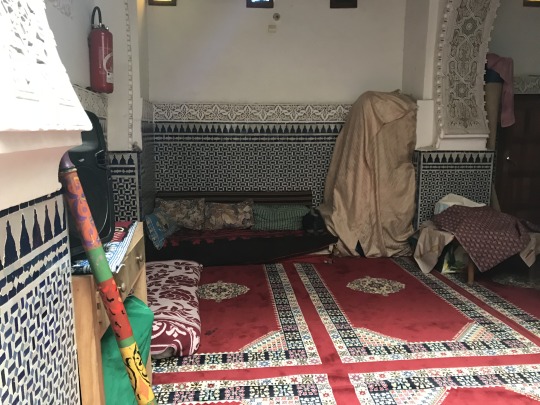
The image above depicts rugs inside of a Zawaya in Fez, Medina. Moroccan rugs can be traced back to the Imazighen. They hold both a practical and religious purpose. Due to the cold climate of the winter months, especially in the mountains, heavy rugs were fashioned to keep warm. Rugs continue to be used for this purpose in the clay buildings of the Medina, which are often even colder than the outside. Homes do not have heating, therefore, rugs are relied upon to help keep the inhabitants warm. Rugs are also used during prayer. As learned on the tour of the Hassan Mosque in Casablanca, part of the Islamic religion requires individuals to get on their hands and knees in prayer five times a day. Before prayer, individuals wash their hands and feet in order to present themselves clean before God. Cleanliness is maintained during the prayer by placing a rug between the filthy ground and the individual. In an Islamic Moroccan home, it is important to remember to remove one's shoes before stepping on a rug in order to keep it clean for prayers.
Arabic Letters
While historians are unsure whether the Imazighen had a written language, it is suspected that the Arabic Alphabet was developed ca. 4th-century B.C.E.
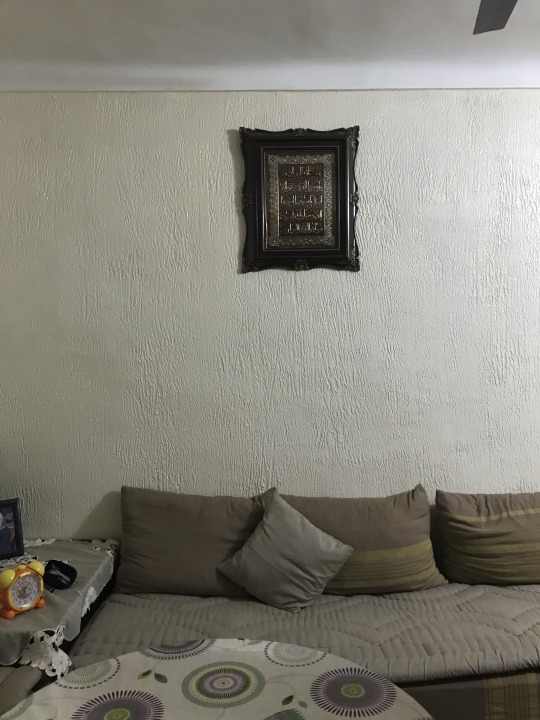
This image was taken inside the home of my host during my stay in Fez. It is a framed verse from the Koran. The first use of the Arabic alphabet is a written form of communication, whether a religious verse or writing a paper for a class. Language is very important in Morocco because it allows access to information. If individuals can read they can better participate in the public sphere because they have gained a necessary understanding of how the world functions. This was portrayed in the book, Year of the Elephant, written by Leila Abouzeid. The main character, Zahra, joined a reading group, where women gathered to learn the written language. This was necessary to inform herself of current events, as she was a part of the rebellion against French colonization.
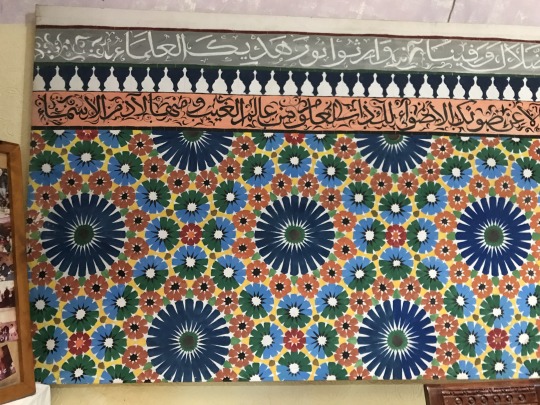
The second function of the Arabic alphabet serves as art. During the mid 11th century Ibn Abdullah as-Samin led a group to overpower the Imazighen and insert their own influence, including art. As learned during Dr. Wafa’s lecture, one prominent Islamic art form is calligraphy. Individuals study calligraphy for years to learn different forms and replicate it onto canvas or even architecture. In the image above, the top of the painting is a row of Arabic calligraphy.
The Medina
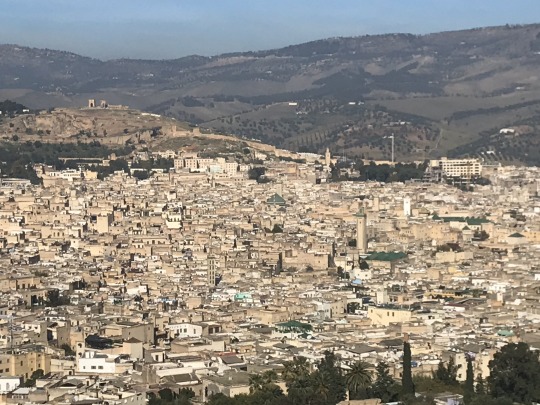
The Medina, in Fez, is recognized as a cultural center of Morocco. Founded during the 9th century, the Medina is home to some of the oldest universities, Mosques, and Fonduks. The buildings are constructed close together, creating tight and narrow pathways. Many homes and shops are within walking distance. Morocco’s collectivist ideals contribute to the multifaceted purpose the Medina’s layout serves. The first function is that it readily allows neighbors to help one another. Living close to one another grants individuals the opportunity to easily seek help which, in turn, strengthens the bond within the in-group and perpetuates a stronger collectivist society. The second purpose is that the layout prompts socialization. Dialogue amongst familiar faces is encouraged as it is likely individuals will pass neighbors around the shops or clusters of homes. By having a close bond with the in-group it perpetuates the desire to care for one another which also strengthens the collectivist ideals of Morocco. Finally, the close layout of the Medina allows for accessibility to resources for every individual. For centuries, homes did not possess running water. Instead, public water fountains were placed throughout the Medina. By having structures built close together it allowed the collective society easy access to the public fountains.
The Terrace
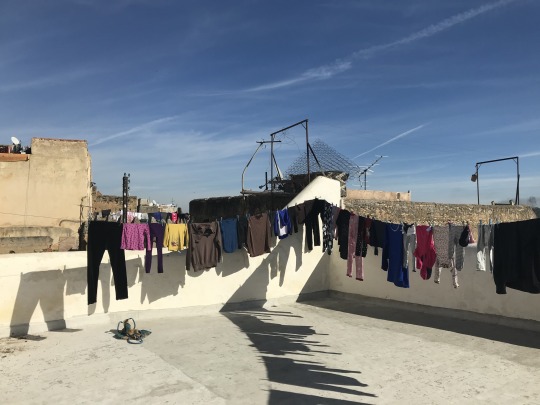
Contrary to the majority of homes in the United States, Moroccans utilize the roof, or terrace, of their homes. The terrace serves two purposes. The first is additional space added to the home. It provides an open space for children play and it is an ideal area to dry laundry since most homes do not have a dryer. The second function of a terrace is a space for women to socialize. Before the 1940′s, when women were more strictly confined to the home, the roof provided a space for them to experience the outdoors. The tall walls around the edge make it challenging for outsiders to see in, while still allowing women a beautiful view and fresh air. Additionally, many homes are structured as an apartment complex where multiple families may share a roof. This strengthens the bond between women as they assist one another with laundry.
Even today, despite the increase of freedom for women, Morocco remains a male-dominant society that has not yet reached a public sphere that equalizes gender. Therefore, women create spaces to prompt socialization and allow themselves to participate in collectivism. Because of this, the terrace continues to remain a vital aspect of the Moroccan home. Mernissi’s mother describes the terrace as one of the “most pleasurable aspects of harem life” (179).
Living Space
These images were taken in the traditional home of our host during our stay in Fez. Moroccans utilize living space by allowing rooms to serve a dual purpose.

The first use for living room space is an area for eating. Meals are an important aspect of family life. They eat at least three meals a day, with tea times in between. As read about in Culture Smart - Morocco, the streets of the Medina don’t usually become crowded until 9:00am, which gives families opportunity to eat breakfast together (93). Individuals have a long lunch break, allowing them to go home for a meal to eat with their family (93).
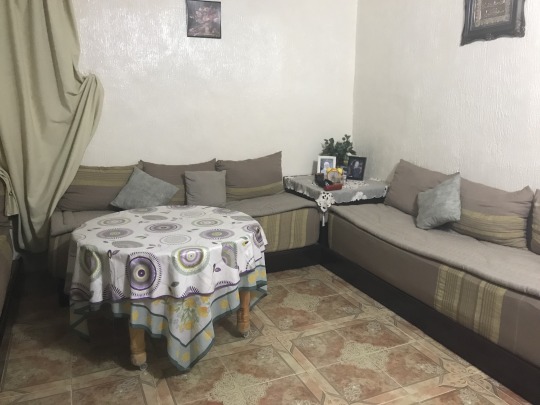
The second function of the living room is an area to socialize. Because of the wheels at the bottom, the table can be moved out of the way. This allows additional room for children to play on the floor. Benches align the room, allowing for multiple guests to enjoy one another’s company. The benches are cushioned and allow for comfortable seating. This is ideal because Moroccans are known for their hospitality and often entertain in their homes.
The Hammam (see image below)

The Hammam is a bathhouse accessible to the public. They can be traced back to the late 8th century. Its purpose is twofold. First, it provides a space for individuals to clean themselves. Hammams were especially important during the earlier centuries when running water was not found in homes. There are separate washing areas for men and women, however, all children under the age of ten usually bathe with the women. Its second purpose is to create a social space. This mostly benefited women, who, before the 1940′s, were rarely allowed outside of the home. Weekly trips to the Hammam were one of their largest social events and they would spend hours together washing and talking. Food would sometimes be present as well. In her book, Dreams of Trespass, Fatima Marnessi’s mother described the hammam as another one of the “most pleasurable aspects of harem life” (179). The socialization aspect of the Hamman was largely perpetuated because women were restricted from interacting in any capacity in the public sphere. When they were allowed out of the home (to go to the hammam) they made the most of their time together.
The Tagine
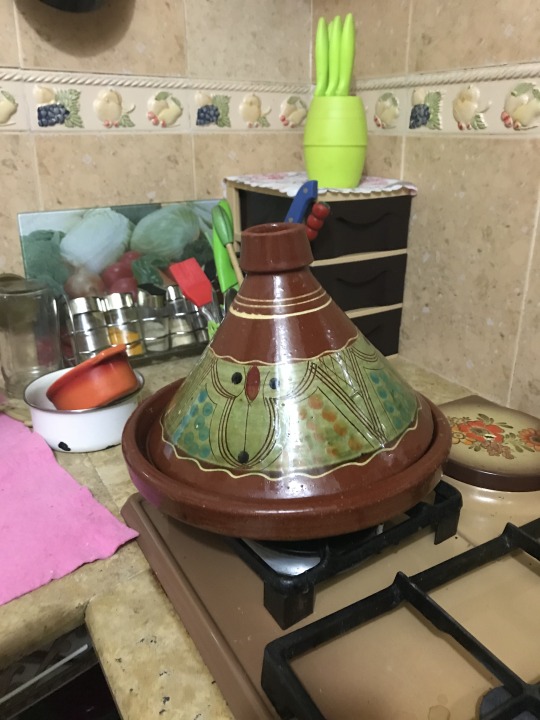
The Tagine, a common item found in the kitchen, can be traced back to the 8th century. It supports the practicality Moroccans maintain by serving two purposes. The first is as cookware. It has a round base with a cone-shaped lid to cover meets, vegetables, or fruits as they cook. Because the tagine is made of ceramic, it can be used in an oven or over the stove.
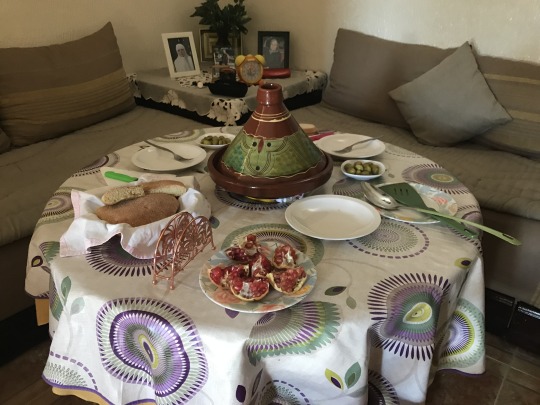
Not only is the tagine used as cookware, but also to serve food. After the meal is finished, the tagine can be placed on the table, ready to feed the family. Additionally, many families eat straight from the tagine, as opposed to each having separate plates. This highlights the acceptability of different norms in a more individualistic society as opposed to collectivism. In America, each individual gets their own serving on their plate. However, in a collectivist leaning society, they are more willing to share with the group and eat from a singular dish of food. By serving a dual purpose as cookware and serving dish, the tagine is a practical kitchen piece.
Cedar Wood

This is an image of cedar wood along the bottom of an ancient mosque in Fez, Medina. It carries both a practical and symbolic purpose. Because cedar wood is resistant to water it protects the walls of the mosque from damage during flooding. This is vital because the Medina lines right along the Fez River, which often rises to fill the walkways during storms. Additionally, it is resistant to insect damage. By placing cedar wood along the walls, the mosque will be preserved for centuries. The second purpose for placing cedar wood along the wall is a symbolic one. In Islam, the cedar tree is a symbol of life given by God. In the Koran, it references the provisions cedar trees provide, such as food and fuelwood. The Cedar is a gift from God and is associated with paradise: “Those on the right hand – happy shall be those on the right hand! They shall recline on couches raised on high in the shade of thornless sidrs and clusters of talh; amidst gushing waters and abundant fruits, unforbidden, never ending” - Sura 56:27-33.
Public Water Fountains
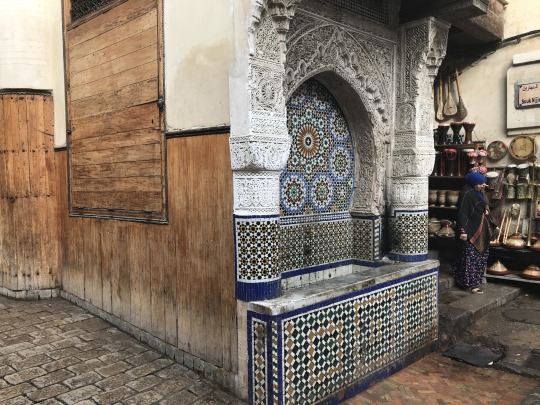
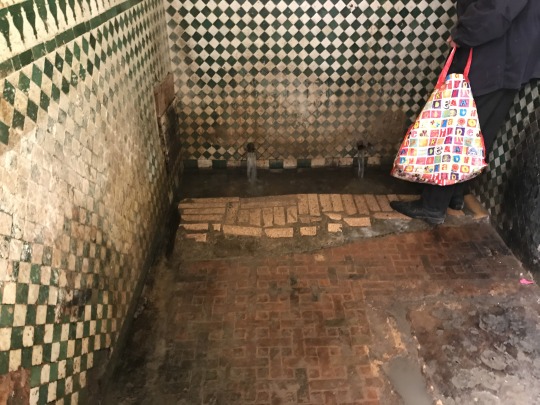
Public water fountains are placed all along the Medina. However, the idea of public access to water can be traced back to the Almoravid Dynasty (1061–1147) and still remain prevalent today. They serve a practical, social, and symbolic function. First, the water fountains are obviously a source of drinking water. Homes in Morocco did not always have running water and therefore these fountains were necessary. Moroccans believe everyone should have access to water and so these fountains continue to assist those who cannot afford to have indoor plumbing or those who live on the streets. This value is a reflection of the collectivist nature of their society. They promote the benefit of the group as opposed to individual “success”. Second, when the main source of water is out in the Medina it requires individuals to leave their home and this promotes socialization. The perpetuation of human interaction is characteristic of a collectivist society. Finally, water holds important symbolism in the Islamic religion. As learned during our tour of the Hassan Mosque in Casablanca, one significance of water is that it represents purity. Before prayer, individuals wash their hands and feet and can then present themselves before God. Additionally, it is a source of life. There is a verse in the Quran that says, “And God has created every animal from water: of them there are some that creep on their bellies; some that walk on two legs; and some that walk on four. God creates what He wills; for verily God has power over all things” (Quran, 24-45).
The Hanut

This is an image of a hanut next to SACAL in Fez, Medina. First and foremost the hanut serves as a marketplace. Here, one can purchase a variety of items, namely food, water, or cleaning supplies. These hanuts are located all across the Medina. Secondly, it prompts socialization. Because a counter blocks the customer from the items they wish to purchase, they must communicate with the hanut owner to ask for products. While the initial dialogue consists of asking for products and bargaining, it allows for the conversation to go further and the hanut owner becomes very familiar with the plans of his customers and their families. In America, a more individualistic society, individuals in the store simply grab the items they would like, purchase them, and then leave. Many grocery stores have even implemented self check out, completely removing the small amount of socialization a cashier provides. Because of the structure of the hanut, the owner becomes very familiar with those who dwell in the cluster of homes around his/her shop as well as their buying habits. This is beneficial because the he can easily detect when something is amiss. During our second Arabic language course, while we were studying in Fez, our teacher explained a scenario that had taken place were the hanut owner was able to assist the police in detaining a terrorist who was making bombs because he had observed a change in their buying habits.
Cafe
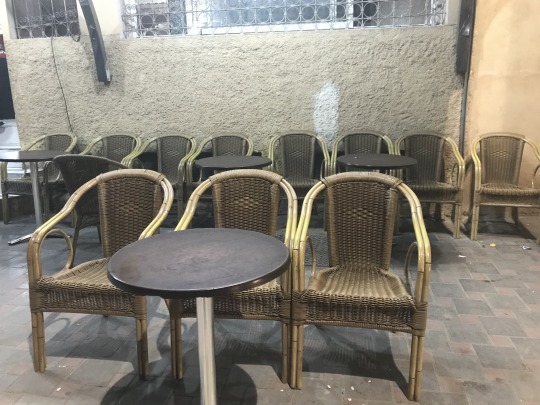
When entering Fez, Medina, this is one of the first cafes one comes across. Cafes are very popular and found all along the Medina. Their first function is a place to eat and drink. This is a shared purpose of cafes across every culture. However, in the Medina they serve a second unique purpose; an observation point to view the public. Instead of placing the chairs around the tables, the chairs are set in a row facing the street. This way individuals can sit and watch passersby and the bustle of the Medina. Locals believe that if someone does not wish to interact with the public sphere, they should stay home, drink coffee, and socialize there. The cafes add a unique factor by encouraging observation of the region in which they live. This is different from America, where even in the public sphere, individuals detach from the world by constantly looking at their phones. Finally, cafes are used for socialization. Because women were rarely allowed in the public sphere before the 1940′s, cafes were, and continue to be, largely occupied by men. They gather to talk or play games.
Shop Doors
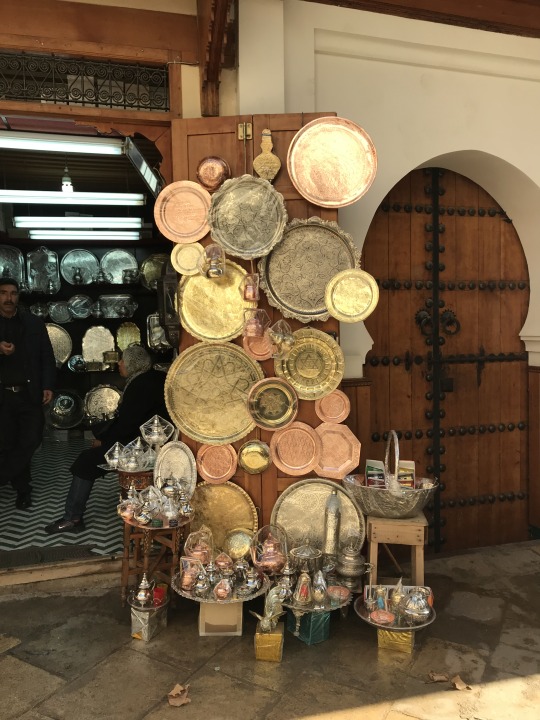
This shop can be found in Fez, Medina. Shops here are small with large double doors, which during open hours have products hanging on them. The first purpose of shop doors is to close when the shop is no longer open. This protects the products overnight. The second purpose is to serve as a space to display products. These small shops are full of goods and to make the most of their space, the shopkeepers utilize the doors. Items on the door are important because this is the first exposure customers experience. If they are interested in any of these goods, they are more likely to then wander inside the shop and continue to look at the products.
Poufs

Poufs are items found in the homes of Moroccans. They hold a variety of usages. One of the main purposes is a chair. These cushions serve as comfortable seating around a table or in a social circle. The benefit to these, as opposed to the long benches usually found in living spaces, is that these are portable and can be carried from room to room, depending on the need. Second, poufs can also be used as a table where one can place decorations, do homework, or, in a small setting, eat around. Finally, poufs also provide a use for old worn out clothes and rags. When purchased, poufs come as a flat pouch of leather or woven material. In order to cushion them, individuals must stuff them will soft materials. In Moroccan culture, materials are rarely ever thrown away. This was supported in Mahi Benebine’s book, Welcome to Paradise, when it read, “in Africa people only throw something away when it’s good for absolutely nothing” (67). Therefore, poufs are beneficial because it serves as a space to store soft clothes that may not have had use otherwise.
Contemporary Art

This is an image of contemporary art hanging in the Musee Mohammed 6th art Moderne & Contemporain in Rabat. Contemporary art became prevalent in Morocco after it was colonized by the French. They tore down the Islamic art schools and built their own. They also taught talented Moroccans the guidelines for contemporary European art. The first purpose of contemporary art is that it is a form to express abstract emotions or for the observer to feel an array of abstract emotions. The image, which appears vague in nature, allows each individual to interpret it to mean something valuable to them. Contemporary art does not align with collectivism as it encourages individual interpretation of emotions. However, a second function to contemporary art is forming; the rekindling of Islamic tradition. Islamic art typically portrayed geometric shapes, floral design, and/or calligraphy. In the image above, one can see the calligraphic letters inside the circle. By incorporating Islamic techniques in a contemporary setting, the artist is reminding the locals of their tradition and preserving their culture.
From the original inhabitant of Morocco to contemporary art, the multifaceted usage of products and space is made evident. This communicates a unique aspect of Moroccan culture that reflects values of resourcefulness, practicality, and socialization.
0 notes
Text
This was the main image used for promoting the event. The painting itself proved to be quite popular and found a really good home. The exhibition is up until February 22.
Months of work came to fruition last Wednesday with the opening of my latest show Until at the Contemporary Art Platform. It was a crazy night, a reunion of sorts. And what better way to share the event with those who couldn’t make it than with pictures. This first batch was taken by my very dear friend Reem Algharabali.
One of my best friends is photographed by another. This is Sarah and her artist husband Matt.
Joseph Fiannaca under Mistletoe. Joseph makes soft-scented, natural soaps among other sensual things.
Huddled in a corner. Unlike popular belief, they are NOT being punished.
My only picture with Azza, who manages CAP. I’ll need to get that remedied.
Lubna and Hamad. Did you taste her warm apple cider that night? Did you hear her sing?
Mona and Aseel.
Peter Duckett. Peter was my Spanish teacher at CAC (Cairo American College) way back in the late 80s. He flew to Kuwait from Bahrain to attend, which was a huge bonus!
Beautiful women, even when their eyes are closed.
My son Khaled, my brother Mohammed and my daughter Zainab. Love, love and love.
The very special Deema Al-Ghunaim. Deema was a great support and actually kickstarted the initial phase of the polyhedron display. I can’t wait to work with her again.
Peter, me and Wafa Rashed. Wafa is one of those people who holds a special place in my heart, despite the fact she’s off social media and I want her back.
CAP owner Amer Al-Huneidi with some guests.
Sara with the sparkly eyes. I can look at her all day. And she’s one of those people whose words roll smoothly off her tongue. In the background is artist Suhaila Al-Najdi.
Up and coming artist Zahra Al-Mahdi, aka Zouz the Bird.
I love this photo. I like how the two sets of women, one on the right and one on the left, mirror each other.
My niece Yasmeen and my daughter Zainab.
This is another shot that beautifully captures the relationship between my paintings and my guests.
Isn’t it wonderful when people grin big. Zeina Mokaddam from PH7 has a giggle with a friend.
A classic beauty, my dear friend and agent Noor Alzabin.
I called it ‘Mistletoe’, many were calling it ‘The Kiss’.
Ladies two and three dimensional.
This slideshow requires JavaScript.
Rania and Aiping.
There was a wide demographic. I’m glad there were younger kids there.
Reham Alsamerai matches my painting.
This slideshow requires JavaScript.
until } reem algharabali’s photos Months of work came to fruition last Wednesday with the opening of my latest show Until…
#art#artist#CAP#colorful#contemporary art platform#Exhibition#gallery#Kuwait#opening#painting#people#polyhedron#show#vernissage
1 note
·
View note